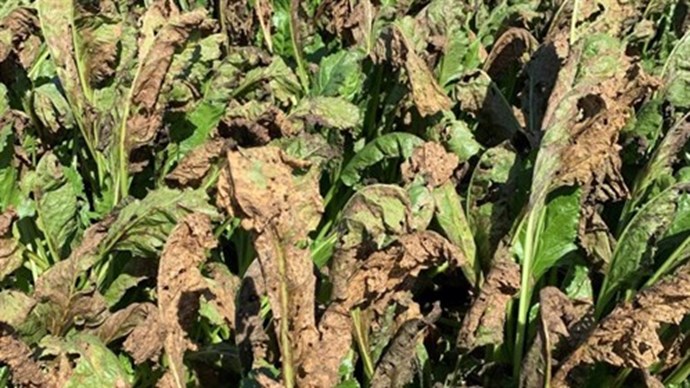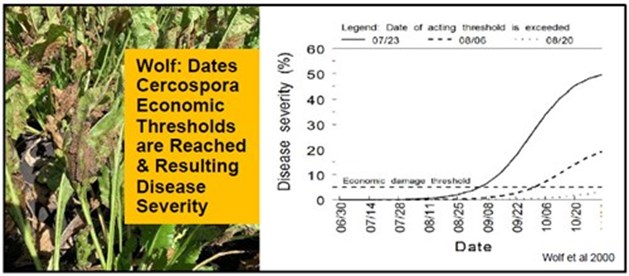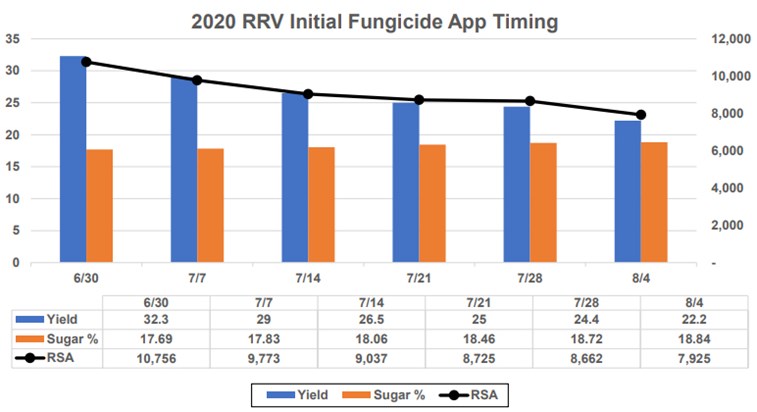618 - New Stinger Formulation
Timing of Initial Cercospora Fungicide Critical to Decrease Disease Severity
New Stinger formulation called Stinger HL
Corteva has come out with a new Stinger formulation called Stinger HL (High Load). This is a more concentrated formulation than Stinger, resulting in Stinger HL being used at lower rates than Stinger to provide the same active ingredient/acre.
| Product | fl oz/a | fl oz/a | fl oz/a | fl oz/a |
|---|---|---|---|---|
| Stinger | 2 | 3 | 4 | 6 |
| Stinger HL | 1.2 | 1.8 | 2.4 | 3.6 |
Both products will be out in the market this year, so it is critical to be aware of what product you are using and applying the correct rate.
- Stinger HL is dyed blue to help distinguish it from Stinger.
- Both Stinger & Stinger HL are labeled to be used on sugarbeets from the cotyledon to 8 leaf growth stage.
- Target common ragweed that has its 1st true leaves and is less than 3 inches tall.
Common ragweed is becoming more difficult to control so it is important to maximize efficacy by spraying either
formulation twice on small weeds.
- Stinger at 3 fl. oz./acre followed by 3 fl. oz./acre
Or
- Stinger HL at 1.8 fl. oz./acre followed by 1.8 fl. oz./acre
Links to Weed Control Quick Sheets

Proper Timing of the Initial Cercospora Leafspot Fungicide Application
Proper timing of the initial fungicide application is key in delaying cercospora leafspot (CLS) infections to keep disease severity low and in-check. The earlier CLS becomes established in a field, the higher the resulting disease severity and
its impact on yield and quality. This is because CLS is polycyclic in its reproduction, producing multiple generations in a single growing season and continually infecting sugarbeet leaves.
- The most critical period for fungicide application is immediately before disease onset (Agrios 2005).
- A properly timed fungicide application delays the time of disease onset reducing the rate at which CLS progresses in the plant population (Rossi 2000).
The chart below from a Wolf 2004 research paper illustrates how drastically CLS Disease Severity can increase with early infections.
- Dashed Line = Economic threshold reached at 3-5% of leaf area infected
- Solid Curve = Early CLS onset @ July 23rd
- Dashed Curve = Later CLS onset @ August 8th
- Dotted Curve = Latest CLS onset @ August 20th

Cercospora Leaf Spot Economic Damage
Pictorial of the 10 CLS Damage Categories:
Economic damage analysis from Wolf’s 2000 research:
- Economic damage occurs at Category 6 Disease Severity, 3-5% of leaf area affected. Recoverable sugar is reduced 2-3%
- Fungicide efficacy is greater than 90% when applications are made at the onset of infection, 0.1% Disease Severity (beginning of category 1)
- Fungicide efficacy can be reduced to less than 80% when the 1st fungicide application is delayed later than 0.2% Disease Severity,
Cercospora infection impacts the sugarbeet in two ways:
- Reduces the photosynthetic active leaf area
- Vegetative regrowth is stimulated because of severe foliage loss
Consequently, potential sugar yield of the sugarbeet crop can be significantly reduced due to the loss of both root weight and sugar content.
Root weight is impacted approximately twice as much as sugar content – (Rossi 2000), (Skaracis 2010).
2020 RRV Initial Timing of Cercospora Fungicide Observations
Data from the ACSC Grower Practices Database indicates that tonnage will continue to decrease the longer the initial fungicide application is delayed. See chart below

The 2020 crop year signifies the importance of a well-timed initial fungicide application. The 5 yr. data also holds true to this trend of initial fungicide timing on yield and RSA.
